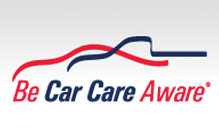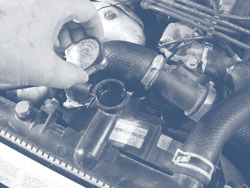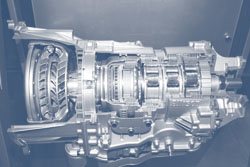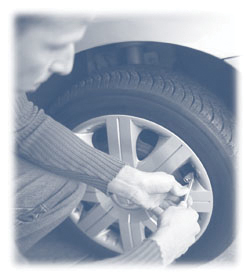

COOLANT (ANTIFREEZE)
What is it?
The most common formulation of antifreeze is green in color and uses ethylene glycol as a base with anti-corrosion additives mixed in. The ethylene glycol part of the formula provides crucial anti-freezing characteristics and the additives deliver the anti-rust and anti-corrosion capabilities. Beginning with 1995 models, most GM vehicles started coming from the factory filled with an extended life antifreeze, trademarked as DEX-COOL®. Distinctively different in appearance, DEX-COOL®, and its aftermarket equivalents, is an orange/amber color. It still uses ethylene glycol as a base, but contains a different additive package than standard green colored antifreeze. This coolant is designed to protect cooling systems for up to 150,000 miles or five years. Other antifreeze formulations include silicate free for Japanese cars and phosphate-free for European cars.
What does it do?
When properly mixed, antifreeze and water provide excellent anti-freeze, anti-boil and anticorrosive properties.
Maintenance Tips/Suggestions
Check your owner's manual for antifreeze usage specifications. Antifreeze, when mixed at a 50/50 ratio with water, provides excellent anti-freeze, anti-boil, and anti-corrosive properties. In extremely cold environments, the ratio for standard ethylene glycol can go as high as 70% antifreeze, 30% water. With DEX-COOL®, the maximum ratio of antifreeze to water is 60/40. Although DEX-COOL® type antifreeze can be mixed with standard ethylene glycol antifreeze, DEX-COOL® loses its 5 yr./150,000 life. As such, it's best not to mix antifreeze types unless absolutely necessary.
All coolants must be diluted with water at the proper ratios and should not be used full strength. Full strength antifreeze actually has a lower freeze point than when mixed with water. Generally, standard ethylene glycol type antifreeze should be changed every two years or 24,000 miles. Even though the coolant freeze protection may test OK with a hydrometer (freeze protection only drops with extreme dilution, not with age), the additives break down over time.
When changing coolant, it also presents an opportune time to replace bad cooling system hoses. Leaking, brittle, spongy, cracked, or rotted hoses should be replaced before new antifreeze is installed. Hose clamp connections should also be checked to ensure that they're secure and free from leaks. If you decide to service your cooling system yourself, use extreme caution: Opening a hot radiator or coolant reservoir/overflow tank can cause severe burns. Be sure that both the engine and cooling system are cool before you begin any heating/cooling system maintenance or repairs. Because of lower hood profiles and cramped engine quarters it's also possible that your car may be equipped with an air bleed for the cooling system. Unless the cooling system is bled properly air may stay trapped in the system and cause erratic temperatures, or in extreme cases, engine or cooling system damage. If you're unsure about any aspect of cooling system service, don't take a chance. Have your car looked at by a professional service technician.

What is it?
Automatic transmission fluid is specially formulated oil containing numerous additives to withstand grueling operating conditions. There are several different types of automatic transmission fluids and should be used according to the recommendation in your car's owner's manual. Some examples include:
What does it do?
Automatic transmission fluid serves a multitude of purposes. Among other things, it cleans, cools, lubricates, transmits force, transmits pressure, inhibits varnish build-up and protects the transmission on a day-to-day basis.
Maintenance Tips/Suggestions
Owner's manual recommendations on transmission fluid changes vary considerably and may go as high as 100,000 miles or more. For best results have your car's transmission fluid and filter changed every two years or 24,000 miles. Always use the type of fluid specified by your car's manufacturer. This information can be found in the owner's manual or on the end of the transmission dipstick. The overwhelming majority of transmission failures are heat related, and automatic transmission fluid breaks down rapidly when subjected to high temperatures.
Driving conditions such as trailer towing, quick stops and starts, ascending and descending mountains, and wheel spinning in slippery conditions are but a few scenarios that can devastate the life of the transmission fluid. Although changing the fluid yourself is not difficult it's probably best left to a qualified service technician. This is also a good time to drain the transmission fluid from the torque converter, if possible. Consult your technician to see if this can be done.

TIRE INFLATION
What is it?
Proper tire inflation pressure is the specified air pressure given by a car maker for a certain tire on a specific vehicle. This pressure specification should not be confused with a tire's maximum pressure, which is usually listed on the tire's sidewall. Some vehicles may specify different pressures for the front tires and the rear tires.
Purpose
Correct inflation pressure is critical for good fuel economy, safety, maximum tire life, and proper vehicle handling performance.
Maintenance Tips/Suggestions
For the small amount of time it takes, checking tire inflation at least once a month is one of the best investments you can make to get the maximum life out of your tires. Proper inflation can also improve gas mileage by more than 3%, when maintained regularly. Keep this in mind: Under inflated tires can lower gas mileage by 0.4 percent for every 1 psi (pounds per square inch) drop in pressure of all four tires. You may want to check your tires more often during the winter months. Tires will lose about 1 psi of pressure for every 10 degrees Fahrenheit of temperature drop.
Keep an accurate tire pressure gauge in your car's glove box (many gauges at "air stations" give false pressure readings) and check the tire pressure when the tires are cold. Never trust the appearance of a tire as a gauge for inflation. A tire could be 10 psi low on pressure and not appear to be low on air.
Use the recommended inflation pressure listed in your vehicle's owner's manual or on the inflation sticker found on the driver's door jamb. While you're at it, don't forget to check the spare. There's nothing more annoying than a flat spare when you have a flat tire.
TREAD DEPTH
What is it?
There are several simple ways to check tire tread depth. The first way is to measure tread depth with a tread depth gauge. The second method involves the use of a penny inserted into the grooves of the tread. Tire wear bars are also used on today’s tires as a hands off visual indication that a tire needs replacement.
What does it do?
Regular tread depth checks are important to ensure that your car’s tires are safe. Excessive wear can result in a loss of traction, especially on wet and slippery roads. Tires are regular wear items and staying on top of their condition not only ensures your safety, but also gives you the opportunity to plan ahead and budget for inevitable tire replacement.
Maintenance Tips/Suggestions
When using a tread depth gauge tires need to have at least 1/16-in. of tread or more. This is the minimum amount of tread allowed by law. By using a penny as a quick reference, insert the penny into the tread groove with Lincoln’s face showing, but with his head upside down. If you are able to see all of Lincoln’s head the tire needs replacement. If you see a wear bar across the width of the tread while facing it, it’s time to replace the tire. Generally, it’s best to replace tires in sets of four. If your car’s tires show signs of abnormal or unequal wear have this looked into by a professional technician. Excessive wear on both outer edges generally indicates under inflation. Excessive wear in the center of the tread generally indicates over inflation. Cupping or dipping of certain tread sections may indicate worn suspension parts or a wheel balance problem. Saw toothed or feathered tread edges may indicate wheel misalignment. If your car needs alignment or suspension work have it done before you drive off with a new set of tires. Taking a “big picture” approach to protecting your tire investment will reap many rewards for miles to come.

CLEAN, WELL MAINTAINED CAR WORTH 50% MORE
Keeping your car clean will significantly help preserve its overall value, according to the Car Care Council.
“Keeping your vehicle clean not only protects your valuable investment, it also fosters a sense of pride and accomplishment,” said Rich White, executive director, Car Care Council. “It’s a task that takes very little money or effort, but delivers huge returns.”
Polishing your vehicle once every six months and washing it once a week prevents the buildup of damaging chemicals and dirt that may harm the vehicle’s finish. In addition to regular care, it is important to watch for any dents, dings, scratches or cracked glass. These problems, when left unattended, can lead to more expensive repairs down the line.
Frequent washing and polishing is also the best way to protect your car’s finish from the damaging effects of harsh ultraviolet rays and acid rain. Acid rain may be of extra concern to vehicle owners in Gulf coast states as the burning of crude oil releases toxic fumes which lead to acid rain.
It is very important to clean your car only with products sold specifically for cars which are specially formulated to ensure that the treatments your vehicle’s manufacturer included on the paint finish remain intact. Using harsh detergents, like dish soap, that are not intended for use of vehicle exteriors can damage those protective layers leaving your vehicle even more vulnerable to the
elements than before you washed it.
For step-by-step instructions on cleaning your vehicle, view the Car Care Council’s “A Clean Car is Cool” article at www.carcare.org/cool.